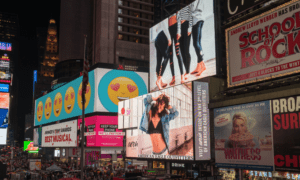Even in an age where digital marketing dominates conversations, businesses continue to invest heavily in billboard advertising.
Billboards remain one of the most visible ways to reach large audiences, offering consistent exposure in high-traffic areas. Their impact is reinforced by decades of use in brand-building and consumer engagement.
A billboard advertising agency helps companies maximize this traditional medium by combining strategic placement with modern data tools. While digital ads can be skipped or blocked, billboards remain present in daily life, making them an essential part of the marketing mix. Understanding why businesses still value this channel reveals its continued relevance.
Broad Reach and Visibility
Billboards are designed to capture attention in places where people naturally gather or commute.
Positioned along highways, city streets, and transit routes, they provide a constant stream of visibility to thousands of individuals each day. Unlike many digital ads that can be easily ignored or avoided, billboards are difficult to overlook in a physical environment.
This consistent presence allows businesses to repeatedly deliver brand messages to the same audiences over time. Whether it’s drivers stuck in traffic or pedestrians walking past a busy intersection, billboards ensure high-frequency exposure. This broad reach is one of the most enduring reasons companies continue allocating budget for outdoor advertising.
Complement to Digital Campaigns
While digital platforms are crucial for reaching audiences online, billboards are a powerful complement to these efforts.
When consumers encounter the same message both on a screen and in their physical surroundings, brand recognition strengthens. This repetition across different channels makes campaigns more memorable.
Businesses also benefit from the trust and permanence associated with billboard advertising. Online ads can feel temporary or fleeting, but a physical billboard reinforces legitimacy. By combining the immediacy of digital with the stability of outdoor media, companies create integrated campaigns that connect more effectively with audiences.
Geographic Targeting and Local Impact
Billboards provide special opportunities for geographic targeting that digital ads cannot fully replicate. A well-placed billboard can influence people in a specific city, neighborhood, or even a single highway corridor. Local businesses often rely on this form of advertising to attract nearby customers who are already close to their stores or services.
National brands also leverage billboards to create regional relevance. For example, a campaign may feature slightly different messages depending on the city to better connect with local culture. This ability to target specific markets while maintaining broad exposure is another reason billboards remain a core marketing tool.
Cost-Effectiveness and Longevity
Cost is a significant consideration in advertising, and billboards often deliver great value for the investment.
When measured in cost per thousand impressions, billboards are competitive with many digital platforms while offering advantages such as uninterrupted exposure. A single placement can generate millions of impressions over a month.
Another benefit is longevity. Unlike digital ads, which require ongoing bidding or risk disappearing once budgets run out, billboards remain in place 24 hours a day. This constant visibility ensures that campaigns maintain momentum without additional daily spending, making billboards a reliable choice for businesses seeking long-term exposure.
Strong Brand Awareness and Credibility
Billboards are highly effective at building brand awareness, particularly when companies want to establish a strong presence in crowded markets. Large, high-visibility displays communicate scale and professionalism, signaling to consumers that the brand has staying power. This perception of credibility often influences how audiences view the business.
Repetition also plays an important role. Seeing the same billboard multiple times during a commute reinforces brand recall.
Over time, this exposure helps businesses move from being unknown to being a recognized and trusted part of the local market. Even without immediate action, the familiarity generated by billboards increases the likelihood of future engagement.
Adaptability to Modern Marketing
Billboard advertising has evolved alongside digital innovation. Traditional static billboards remain common, but digital billboards have opened new possibilities. These displays allow businesses to rotate multiple messages, update promotions in real time, or align campaigns with events and weather conditions.
Interactive features such as QR codes or short URLs also connect physical billboards with online platforms. This adaptability guarantees that billboards continue to play a role in modern marketing strategies, bridging the gap between offline visibility and online engagement. For businesses seeking flexibility, billboards are no longer limited to one static message.
Why Billboards Still Matter in a Digital World
Despite the rise of online marketing channels, businesses continue to invest in billboards because they deliver reach, visibility, and impact that digital platforms alone cannot provide. They complement online efforts, target audiences geographically, and remain cost-effective over time. They also strengthen brand awareness and credibility while evolving to integrate with digital campaigns.
Far from outdated, billboards remain a proven and adaptable part of modern marketing strategies.
































